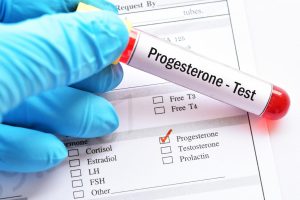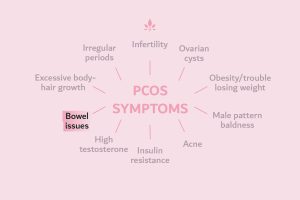I Have Regular Periods; Could I Still Have PCOS?

- It is possible for women to have PCOS but still have regular periods.
- PCOS symptoms do not always include irregular periods;
- Many women with with PCOS but regular periods do also experience difficulties with ovulation.
Polycystic Ovary Syndrome (PCOS) is the most common endocrine condition affecting females of reproductive age, with a suspected prevalence rate of between 4 and 10%.
It is a challenging condition to both diagnose and treat as it presents with a variety of symptoms that can differ in intensity and impact from patient to patient. One of the most common symptoms is irregular periods, which affect some, but not all women with PCOS symptoms.
A diagnosis of PCOS is often made after the exclusion of other conditions. In 2003, the Rotterdam consensus established a set of guidelines to assist with diagnosis. These guidelines stated that for a diagnosis to be made, patients should present with two out of three of the following symptoms:
- Oligo/anovulation.
- Clinical or biochemical hyperandrogenism.
- Polycystic ovaries.
Whilst not part of the standard diagnosis of PCOS, insulin resistance and obesity are also heavily associated with the condition.
PCOS and fertility
Not all women with PCOS have fertility issues, but a significant number do. Many women first identify a problem when they struggle to conceive and it is only upon undergoing investigations for infertility that they receive a PCOS diagnosis.
As many as 70-80% of women with PCOS will have fertility problems and the condition is the primary cause of anovulation in women of reproductive age.
One of the most obvious signs that there is an ovulatory issue is menstrual cycle disturbances. 75-85% of patients with PCOS will have irregular menstrual cycles. Infrequent periods, also known as oligomenorrhoea, occur when a female has less than 8 periods a year and/or an interval of 35 days or more between bleeding.
80-90% of women who seek medical assistance for oligomenorrhoea will be diagnosed with PCOS. Thus, it is very common for women with PCOS to have irregular periods.
Is it, however, possible to have regular periods, and still be diagnosed with PCOS?
The answer to this is yes.
If you are concerned you have PCOS, take an at-home PCOS blood test. It is a quick, discreet and convenient way to find out whether you have polycystic ovary syndrome. Based on your test results, you will get tailored advice to help you correct any imbalances or deficiencies.
Diagnosis of PCOS but periods are regular
There are two main scenarios that might result in a female having PCOS with regular periods.
1 In adhering to the Rotterdam guidelines, only two out of three symptoms are required for a diagnosis of PCOS to be made. Therefore, a female might have polycystic ovaries and exhibit signs of hyperandrogenism, but maintain regular ovulatory cycles.
With regular ovulatory cycles, her periods will probably also be regular, but her other symptoms would be sufficient for a positive diagnosis. Women who ovulate regularly are less likely to experience infertility.
2 Ovulation can be severely disrupted with no obvious effects on the regularity of menstruation. 20-50% of hyperandrogenic women with normal periods, have chronic anovulatory cycles, and regular periods are not a guarantee that ovulation is occurring.
This can be a particularly difficult situation for those women who are using their periods to track their fertile days with the aim of falling pregnant. Without ovulation, fertilisation cannot occur.
The only way to confirm the presence or absence of ovulation clinically is to have a blood test; however, women who are experiencing anovulatory cycles might find that they do not experience typical premenstrual symptoms, such as bloating, irritability and sore breasts.
Clinical confirmation of ovulation comes from monitoring serum progesterone levels. Normally, immediately after ovulation, progesterone levels will rise rapidly, marking the luteal phase of the cycle. It is not unusual for progesterone levels to reach 10ng/mL. If levels remain below 3-4 ng/mL ovulation is extremely unlikely to have occurred.
The masking effects of the oral contraceptive pill
There is another scenario whereby a woman may believe she is having regular periods following a PCOS diagnosis.
Many women take the oral contraceptive pill; and its usage today extends far beyond solely preventing pregnancy. Women take it to manage heavy periods, to alleviate the symptoms of the peri-menopause and to reduce the effects of premenstrual syndrome.
It is a valuable tool in the management of endometriosis and its anti-androgenic properties mean that it is often given to women with PCOS. The combined oral contraceptive pill results in monthly bleeds, and thus, it is not unreasonable to assume that it is also effectively restoring cycle regularity.
However, these are withdrawal bleeds rather than normal menstruation and it is highly probable that unless appropriate lifestyle changes have been implemented, once treatment ceases, cycles that were previously irregular will become that way once again.
Nabta is reshaping women’s healthcare. We support women with their personal health journeys, from everyday wellbeing to the uniquely female experiences of fertility, pregnancy, and menopause.
Get in touch if you have any questions about this article or any aspect of women’s health. We’re here for you.
Sources:
- Azziz, Ricardo, et al. “The Androgen Excess and PCOS Society Criteria for the Polycystic Ovary Syndrome: the Complete Task Force Report.” Fertility and Sterility, vol. 91, no. 2, Feb. 2009, pp. 456–488., doi:10.1016/j.fertnstert.2008.06.035.
- “Long-Term Consequences of Polycystic Ovary Syndrome.” Royal College of Obstetricians and Gynaecologists, Nov. 2014, www.rcog.org.uk/globalassets/documents/guidelines/gtg_33.pdf.
- “Polycystic Ovary Syndrome (PCOS).” ACOG, June 2017, www.acog.org/Patients/FAQs/Polycystic-Ovary-Syndrome-PCOS.
- Teede, H, et al. “Polycystic Ovary Syndrome: a Complex Condition with Psychological, Reproductive and Metabolic Manifestations That Impacts on Health across the Lifespan.” BMC Medicine, vol. 8, no. 1, 30 June 2010, doi:10.1186/1741-7015-8-41.










